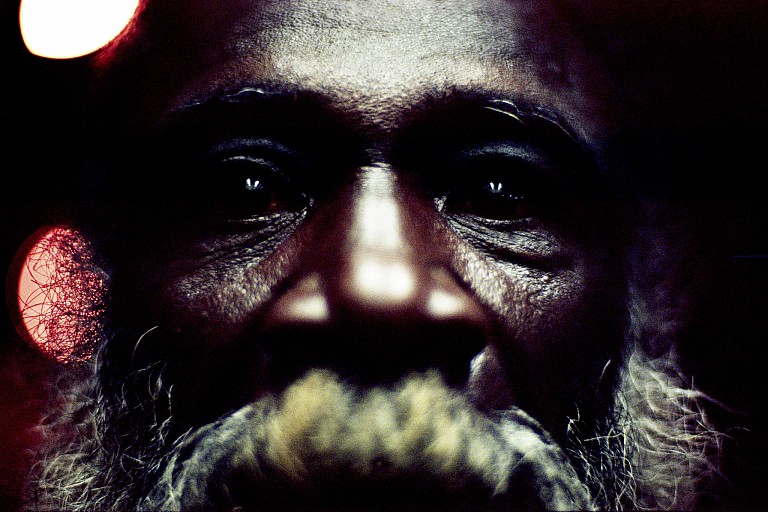
Recent Press
May 8, 2018
KHALIK ALLAH in COLLECTOR DAILY
By Loring Knoblauch
JTF (just the facts): A total of 17 color photographs, framed in white and matted, and hung against white walls in the main gallery space. All of the works are pigment prints, made between 2013 and 2017. Each print is sized 14×21 inches and is available in an edition of 9.(Installation shots below.)
A monograph of this body of work entitled Souls Against the Concrete was published in 2017 by the University of Texas Press (here). Hardcover, 208 pages, with 105 color photographs.
Comments/Context: For Khalik Allah, a young black man trying to find his way through the world, the corner of 125th Street and Lexington Avenue in Harlem, especially at night, was just the kind of place he wanted to avoid. Having discovered filmmaking and having had some initial success with his first projects (rap videos for various members of the Wu-Tang Clan), he had largely stayed away from the neighborhood corner that symbolized so many of the problems that plagued the local black community – drug use and addiction, police harassment and brutality, persistent homelessness and poverty. But when he made the switch to still photography, Allah felt instinctively drawn to that particular spot, almost like he was forcing himself to face the harsh realities of the street life that he had largely escaped in the past.
Since 2012, Allah has been pointing his camera at this single corner in New York, persistently looking where no else wanted to look and making rawly intimate pictures of what had become stubbornly invisible. Consistently shooting late at night, he slowly built up a mutual sense of trust with the locals, enough so that he could make his pictures without overtly intruding or causing a scene. And as he became a more comfortable presence there, his connections with the regulars grew stronger, thereby allowing their truths to come out.
As seen in this gallery exhibit, Allah doesn’t take sides, seeing both the positives and negatives in this world with similar clarity. His faces often seethe with anger, desperation, strung out jangliness, and even a few bouts with delusion and psychosis, but these moments of intensity and trauma are always balanced by quieter moods, where resignation, warmth, and pensive reflection take hold. Anguish gives way to a sparkle of joy, wariness turns to momentary swagger, and depression shifts towards muted hope, the cycles of emotion simmering through the dark night. What never wanes is the sense of dignity and humanity in Allah’s pictures. Every subject is seen as a real person (rather than an anonymous ghost, a threat, or a problem), and that honest one-to-one engagement with these overlooked and forgotten people is what enables the powerful connections he has captured.
Photographically, Allah shoots in the darkness of the night, using only the available light of the streets. As a result, the glow from storefront doorways, the washes of light from passing car headlights and emergency vehicles, and the pin pricks of lampposts provide the entirely of the ambient setting for his portraiture. In these low light conditions, as he gets in close to faces, the dappled backgrounds naturally dissolve into flares, leaks, and blurs, the light and color becoming improvisational accompaniments to the facial expressions. And as Allah shoots on film, when these prints are enlarged beyond their original range of sharpness, the grain comes out, adding another layer of colored texture.
The best of Allah’s pictures combine this sparkling urban light show with a gut-wrenching sense of empathy. Unnamed sitters peer into the camera lens, their eyes full of fear, or sadness, or derangement, or weariness, each surrounded by this symphony of abstract color and pattern. Wafts of blown smoke provide yet another compositional element, creating tactile fogs of uncertainty that soften the harshness of the glares. And while many photographers have used enveloping darkness as an environment of mystery (the Australian photographer Bill Henson, as a notable example), Allah uses it like a tapestry of energy, the colors animating and enriching the expressive alertness found in his pictures.
The durable power in Allah’s portraits lies in his unflinching willingness to connect, to take the risk of engaging with someone who may at first be rightfully fearful or defensive. The pictures found here are not those of a casual tourist wandering the streets of Harlem. They represent an open commitment to the downtrodden, and to an authentic process of mutual exchange with those living on the margins. There is no exploitation here, only a search for universal stories to tell. These are pictures that let us vicariously experience the varied hardships of the streets, and that further encourage us to react and to respond.
Collector’s POV: The prints in this show are priced at $3000 each. Allah’s work has no secondary market history at this point, so gallery retail remains the best option for those collectors interested in following up.
Back to News
